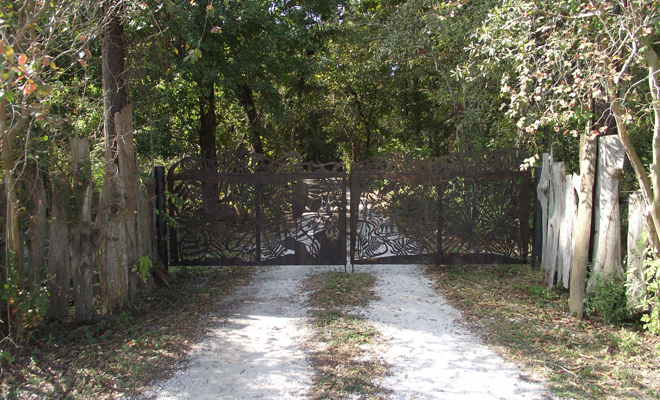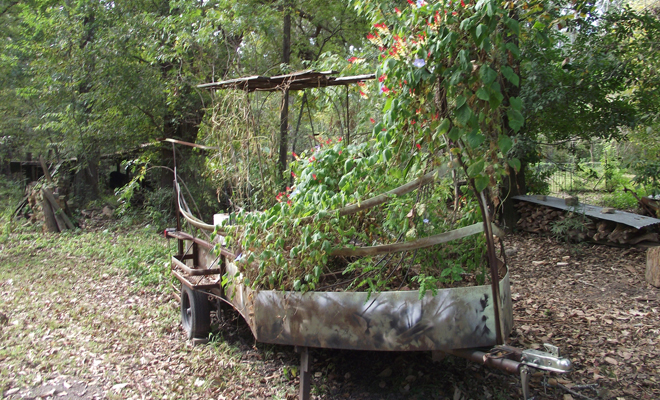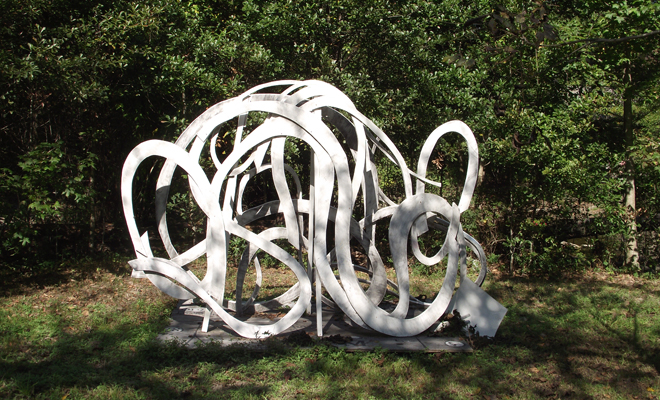The Art of the Environment: A Studio in the Woods

The entry gates to A Studio in the Woods were designed by metalsmith Karen Rossi.
Start at the beginning, where the River Road comes to an end. There you'll find the first of many pieces awaiting discovery: a set of double bronze gates, decorated with all the flora and fauna found past them—oak and pecan trees, ferns, palmettos, snowy egrets, brown owls, and skinks. Carefully rendered by the metalsmith Karen Rossi, the gates welcome you to A Studio in the Woods, an artist's retreat founded in 2001 by husband and wife Joe and Lucianne Carmichael.
The Studio is best known for its residency program, which hosts artists of all disciplines for up to six weeks to pursue projects in conjunction with a theme. Past themes have included “Changing Landscapes,” “The Mississippi River,” and “Restoration,” the latter being a series of residencies that followed Hurricane Katrina. But inasmuch as the Studio has provided artists a place to work, it has also become, over time, a place of work. The grounds—7.6 acres of endangered bottomland hardwood forest currently managed by Tulane University environmental curator David Baker—contain sculptures, paintings, installations, and earthworks which call to mind sites such as the sculpture park at the New Orleans Museum of Art, or, further afield, the National Gallery of Art in Washington or the Henry Moore Foundation in Leeds. These artworks appear in places both expected—at points of interest such as the house, the garden, and the central pond—and unexpected, such as buried underneath an aging elm, where poet Moose Jackson once staged a performance.
Undoubtedly, the house is the central repository of the collection, with works hanging on the walls, resting on shelves, and mounted from the ceiling. Many of these works were either commissioned or bought by the Carmichaels, such as a large-scale oil painting by Robert Nevil which depicts the story of the Studio, or donated by former resident artists, including such artists as Jane Hill and Karen Rich Beall. But the house is more than just a location for the work. Originally designed by the Carmichaels—Joe, a woodworker, and Lucianne, a potter—who made extensive use of salvaged and discarded materials to create a low-impact, intimate structure which has grown with the surrounding landscape as much as it has drawn from it, the house has, over the last four decades, become a continually evolving work all its own.
Many of the windows in the house, for example, are in fact reclaimed cypress doors, salvaged from a New Orleans school which had closed in the 1970s. A brief exploration around the property reveals that several of these doors are garlanded with ceramic markers that Lucianne fired on special occasions, such as the night of their housewarming party on New Year's Eve, 1977, shortly after the house was first completed. A central circular window on the east side, executed in stained-glass by Polly Verlander, takes as its inspiration both the shape of the Mississippi River and the poem by Elizabeth Barrett Browning that begins “How do I love thee? Let me count the ways.” The poem, which celebrates love throughout eternity, is one that the Carmichaels surely observe. The running lights and door handles in the kitchen, crafted by the late metalworker Carl Thorsen, were intended to reflect the vines and lianas that grow outside in the forest, and even the floor tiles, an intricate hexagonal latticework of plain russet clay and stylized natural scenes, reflect the Carmichaels' handiwork: they fired and laid each one by hand.

Tory Tepp's Spirit Ferry, fashioned from a flatbed trailer, now serves as a portable flower garden.
Stepping outside, the grounds harbor other stories. Karen Rossi’s pink octopus on the boardwalk over the pond invites the visitor to sit quietly and observe the life around and underneath the water, just as, on its eastern edge, the remnants of a raft by the sculptor Bernard Williams recall the perilous (not to mention illegal) solo journey he took out into the middle of the Mississippi River in early 2011. Tory Tepp's Spirit Ferry, a mobile installation of a boat fashioned from a flatbed trailer, is "moored" by the woodshed, serving as a portable flower garden in which brilliant cerulean morning glories are currently in bloom. Other interventions hint at works yet to come, such as the planned Moira and Stephen Ambrose Memorial Writer's Cabin, a stand-alone building which will entertain writers whose work addresses environmental issues. Currently a sign marks the location of the cabin; as well, it quietly marks the books yet to be written.
This brief tour only begins to explore the wonders found at A Studio in the Woods. The most important aspect of the site, however, is that its physical landscape and its artistic landscape are both ever-changing, influenced as much by the seasons and fluctuating water table as the rotating cast of artists at work. Operated by Tulane University since 2001, the Studio regularly hosts events, educational activities, and an annual FORESTival to bring the wider community into the forest. This year marks the tenth anniversary of the Studio, an anniversary marked by a range of events in and around New Orleans, but the flagship initiative of the Studio remains its residency program. As of this writing, the landscape artist Roy Staab is in residence, taking the riverbank and the central pond—domain of dragonflies, water turtles, moccasins, and visiting egrets—as his site. While his work is still in process, Staab's presence, like the work of so many others past and future, suggests that the art of the environment at A Studio in the Woods, true to form, will continue to evolve over the course of the decade to come.

The remnants of a raft by the sculptor Bernard Williams recall his journey into the Mississippi River in 2011.
Editor's Note
A Studio in the Woods is located at 13401 Patterson Road in New Orleans. Tours of the grounds are available by appointment only. Visit astudiointhewoods.org for more information, or call 504.392.5359. The author, Benjamin Morris, was the second of five residents in the 2011-2012 “Ebb & Flow” residency cycle.



